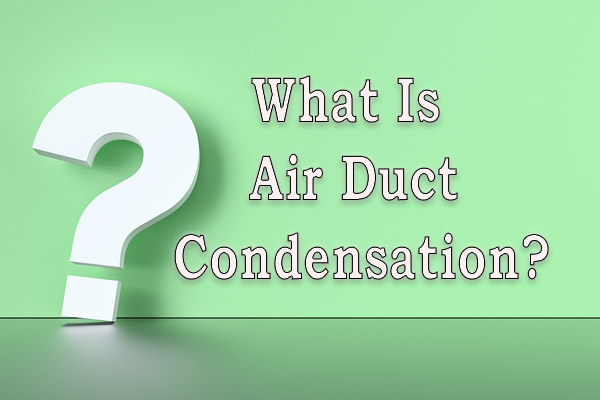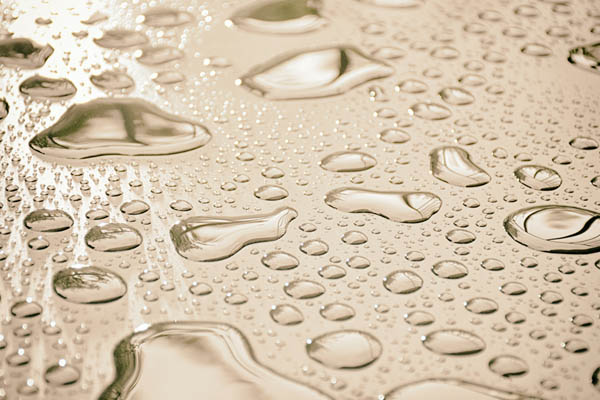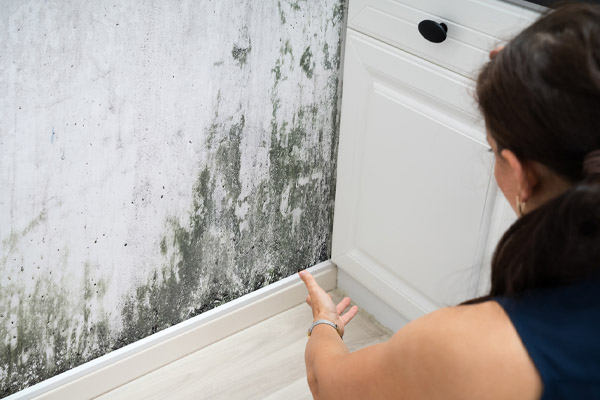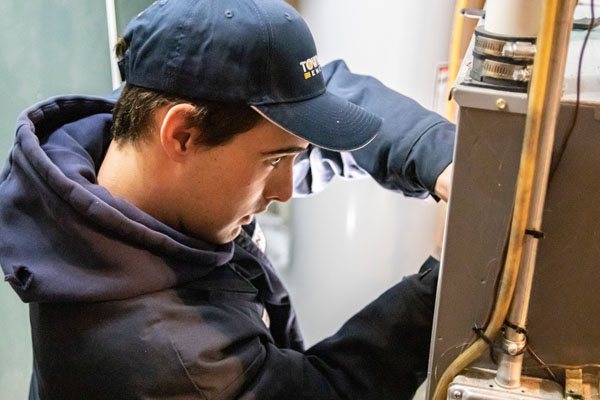Why Is Condensation On Air Ducts A Cause For Concern?

Moisture accumulation on HVAC air ducts poses significant concerns. Air duct condensation not only jeopardizes your HVAC system’s health but also impacts indoor air quality. Excess moisture on these vital components fosters an ideal breeding ground for mold and mildew, which can give rise to health complications and hinder optimal air circulation. Additionally, condensation can inflict harm on the ductwork, potentially leading to structural issues and decreased system efficiency.
Understanding the root causes and repercussions of air duct condensation is paramount for our team at Townsend Energy as we strive to promptly address and resolve this concern, ensuring your HVAC system’s longevity and optimal performance.
Why Is Condensation On Air Ducts A Cause For Concern?
Contents
While condensation on air ducts may raise concerns, it does not necessarily signify the end of your HVAC system’s life. We are here to share insights on mitigating its impact and safeguarding your heating and cooling system.
Defining Condensation

Condensation is the natural process wherein water vapor transforms into liquid water upon contact with a cooler surface. Think of the familiar scenario when you pour a cold beverage into a glass on a scorching day. As the chilled liquid meets the glass’s exterior, tiny water droplets begin to form on its surface. This occurs because the glass is cooler than the surrounding air, causing the water vapor in the air to release heat and convert into liquid droplets. This transformation is driven by the temperature variance between the air and the cold glass, converting water vapor into its liquid form.
Similarly, condensation can occur on HVAC air ducts due to the same phenomenon. When the cold air flows through the ductwork, it chills the ducts. For instance, when the warmer ambient air interacts with these cooler ducts during HVAC system operation, it triggers excessive sweating or condensation on the ductwork.
However, it’s essential to note that while this temperature difference is a common cause of ductwork condensation, it is not the sole factor. There exist several other reasons why your ductwork might experience condensation, which we will delve into later in this informative guide.
Impact of Condensation on Ductwork

The effects of condensation on ductwork can be substantial and concerning. Here’s a detailed look at how this moisture-related issue can affect your HVAC system and indoor environment:
- Mold and Mildew Growth: Excess moisture accumulation provides an ideal breeding ground for mold and mildew within the ductwork. These microorganisms can propagate and spread throughout your home, compromising indoor air quality and potentially causing health issues for occupants.
- Structural Damage: Condensation can harm the ductwork’s structure over time. The persistent moisture can lead to corrosion, rust, and general deterioration of the ducts, weakening their integrity. This deterioration can result in air leaks, diminished airflow, and increased energy consumption.
- Reduced Efficiency: Condensation on the ducts disrupts the smooth flow of air. Moisture accumulation can cause obstructions and blockages, impeding the efficient distribution of conditioned air within your living spaces. This can lead to uneven cooling or heating, reduced comfort, and higher energy usage.
- Increased Energy Costs: When condensation compromises the ductwork, the HVAC system may be compelled to work harder to compensate for reduced airflow. This extra effort translates to higher energy consumption and increased utility bills.
Factors Contributing to Air Duct Condensation

Understanding the root causes of condensation in air ducts is crucial. Here are the key factors that can lead to condensation within your HVAC system’s ductwork:
- Temperature Discrepancy: The primary trigger for condensation in air ducts is the contrast in temperature between the cooler air inside the ducts and the warm, humid air surrounding them. When warm air encounters the cooler duct surfaces, moisture in the air condenses, forming water droplets.
- Elevated Humidity Levels: Higher humidity levels in your home or the surrounding environment can contribute to condensation on air ducts. Air saturated with moisture can release excess water upon contact with a cooler surface.
- Inadequate Insulation: Ducts with insufficient insulation can foster temperature variations between the ducts and the surrounding air. This temperature difference encourages condensation to form on the duct surface.
- Air Leakage: Leakage within the ductwork can introduce warm, humid air from areas like attics, crawl spaces, or basements into cooler ducts. The mixing of different air temperatures can promote condensation.
- Insufficient Ventilation: A lack of proper ventilation within the duct system can hinder effective airflow, leading to the accumulation of stagnant air. Stagnant air increases the likelihood of condensation.
- Improper Duct Installation: Ductwork that is poorly designed or improperly installed may result in air leaks, temperature imbalances, and condensation issues.
Recognizing and addressing these underlying causes of condensation is vital in preventing moisture-related problems. For a precise diagnosis and resolution of condensation issues in your air ducts, consider consulting with our professional HVAC technicians at Townsend Energy. We are committed to ensuring your HVAC system’s optimal performance and longevity.
Preventing Condensation on HVAC Ductwork

To safeguard your HVAC system’s ductwork from condensation, consider implementing these practical measures:
Insulate The Ductwork
Employ proper insulation for your air ducts, utilizing materials with a high R-value. Adequate insulation helps maintain the duct surface temperature, reducing the likelihood of condensation. Ensure that your insulation meets high-quality standards.
Seal Duct Leaks
Air leaks within the ductwork can introduce warm, humid air, setting the stage for condensation issues. Engage your HVAC contractor to seal any leaks or gaps meticulously. They can utilize mastic sealant or metal tape to create airtight ducts, preventing the intrusion of unwanted moisture.
Appropriate Vent Sizing
Ensure that supply and return vents are correctly sized to facilitate good air circulation throughout your space. Properly sized vents contribute to efficient airflow, reducing the risk of condensation.
Controlling Indoor Humidity
To further combat condensation issues, manage indoor humidity levels effectively by following these guidelines:
- Utilize Dehumidifiers: Employ dehumidifiers to regulate and reduce indoor humidity levels. These devices help keep humidity within recommended ranges, typically between 30% and 50%. Maintaining humidity within these boundaries minimizes the potential for condensation.
- Ventilation Systems: Consider installing ventilation systems designed to circulate and control indoor air quality. These systems can aid in maintaining optimal humidity levels and preventing excess moisture from accumulating within your home.
Ensuring Proper HVAC Sizing

To mitigate condensation concerns effectively, it’s imperative to ensure that your HVAC system is correctly sized to meet the specific needs of your home. Oversized or undersized systems can exacerbate condensation issues. Engage the expertise of HVAC professionals to determine the appropriate size for your HVAC system based on your unique requirements. Their knowledge and experience will help you select the right system size to avoid condensation problems.
Regular Maintenance is Key
Routine HVAC maintenance is vital in identifying and addressing potential condensation issues before they escalate. It allows HVAC technicians to detect and address condensation-related problems promptly. This proactive approach helps prevent further issues from developing.
In Conclusion
You can successfully eliminate condensation on your air ducts by addressing the root causes and taking appropriate preventive actions. Regular maintenance of the ductwork, the use of whole-house dehumidifiers and humidifiers, and the addition of insulation to the HVAC ducts are all effective methods to combat this issue. With a better understanding of these causes and solutions, you can enjoy efficient and reliable cooling throughout your living space.
Contact Townsend Energy For All Your HVAC Needs

When it comes to heating and cooling services in Northeastern Massachusetts, Southern New Hampshire, and Maine, Townsend Energy is your trusted industry leader. Our team comprises highly skilled and certified technicians specializing in HVAC tune-ups, repairs, installations, and replacements. We take great pride in delivering top-quality services to each one of our valued clients.
At Townsend Energy, we recognize the significance of a comfortable and energy-efficient home. That’s why we offer competitive pricing for our comprehensive range of services. Our maintenance services are meticulously designed to enhance your comfort and reduce energy bills. If you find yourself in need of an HVAC repair or replacement, rest assured that our knowledgeable technicians will recommend the best solution, all while keeping your budget in mind. We are dedicated to the excellence of our work and back it up with a satisfaction guarantee.
Scheduling a service appointment with us is a breeze – simply contact us today. We also offer complimentary, in-home estimates to assist you in making informed decisions regarding your HVAC systems. Trust Townsend Energy to deliver exceptional heating and cooling services that consistently surpass expectations. Your comfort is our priority!
Contact us now at (800) 722-4101 to find out more! Click the link to view our service area.
Related Articles:
- 10 Winter Hacks for a Warmer House Without Cranking Up the Thermostat
- 7 Must-Have Accessories To Improve HVAC Performance
- 5 Things To Check On The HVAC System When Buying A New Home
- How HVAC Comfort Zones Cut Energy Costs
- Why Is HVAC Airflow So Important For My Home?
- Follow These Simple Tips To Improve Your Home’s Indoor Air Quality
